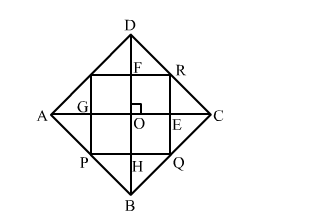Show that the quadrilateral formed by joining the midpoints of the pairs of adjacent sides of a rhombus is a rectangle.
Show that the quadrilateral formed by joining the midpoints of the pairs of adjacent sides of a rhombus is a rectangle.

Let ABCD be a rhombus and P, Q, R and S be the midpoints of AB, BC, CD and DA, respectively.
Join the diagonals, AC and BD.
In ∆ ABC, we have:
$P Q \| A C$ and $P Q=\frac{1}{2} A C$ [By midpoint theorem]
Again, in ∆DAC, the points S and R are the midpoints of AD and DC, respectively.
$\therefore S R \| A C$ and $S R=\frac{1}{2} A C$ [By midpoint theorem]
Now, PQ ∣∣ AC and SR ∣∣ AC ⇒ PQ ∣∣ SR
Also, PQ = SR [Each equal to $\frac{1}{2} A C$ ] (i)
So, PQRS is a parallelogram.
We know that the diagonals of a rhombus bisect each other at right angles.
∴ ∠EOF = 90o
Now, RQ∣∣ DB
⇒RE ∣∣ FO
Also, SR∣∣ AC
⇒FR ∣∣ OE
∴ OERF is a parallelogram.
So, ∠FRE = ∠EOF = 90o (Opposite angles are equal)
Thus, PQRS is a parallelogram with ∠R = 90o.
∴ PQRS is a rectangle.
